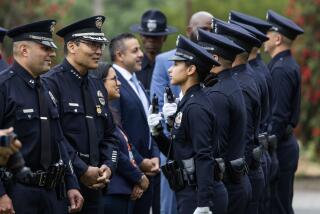Use of Force Called Restrictive : S.D. Police Policy Assailed in Wake of Officer’s Death
- Share via
SAN DIEGO — Police officers, stunned by the slaying of the third officer in less than seven months and alarmed by statistics showing a higher police mortality rate in San Diego than in any other U.S. big city, spent Monday wondering “what’s going on here?”
Sunday’s shooting death of Police Officer Thomas E. Riggs, along with the wounding of another officer and a civilian “ride-along,” produced smoldering criticism from some San Diego officers upset by longstanding Police Department policies that they believe unnecessarily restrict an officer’s use of force.
“Maybe society has changed and we haven’t,” said one officer. “People don’t try to get away from you any more. They just attack you. The procedures need to be changed . . . Attitudes need to be examined.”
Another officer said: “This city is not vicious; that’s not why our cops are dying. It’s not so much the substance of the training our new officers receive, but the philosophy of training. There needs to be a new line drawn: When citizens offer up violence, we should respond with violence immediately--not wait for the suspect to push all the right buttons before you can properly defend yourself.”
A third police official added, “The real question is: What’s going on here?”
Split With Kolender
Monday’s rumblings within the ranks represent one of the few recent occasions when San Diego’s officers have expressed differences with the relatively liberal law enforcement policies of Police Chief William B. Kolender.
Kolender said Monday that he has no immediate plans to change departmental policy in the wake of Sunday’s incident, nor does he plan to revamp or discontinue the civilian ride-along program.
“Right now, we’re seeing what the officers did Sunday night and how they did it, and then we’ll make judgments on policy,” Kolender said. “As for the ride-along, we’ve had it 15 years, it’s effective and this is the first incident that we know of where someone was hurt. Ride-alongs being injured is certainly not a pattern.”
More than 1,000 civilians--from teen-agers to community activists--ride on patrol each year with the 1,300-member Police Department. Commanders say the program is intended to help erase false impressions of the Police Department and has proven to be an effective recruiting tool.
After signing an insurance waiver and receiving a briefing on the operation of a police radio and siren, ride-along civilians respond with police officers to routine as well as emergency calls. They have been credited more than once with assisting officers in distress.
The civilian wounded Sunday, Sara Pena-Ruiz, 32, of Southeast San Diego, was in a police cruiser with Riggs, 27, when they stopped a few blocks from her house to assist another officer, Donovan Jacobs. Jacobs, 28, had stopped a pickup truck carrying eight young men and was questioning the driver, identified by police as Sagon Aahmes Penn, 23.
When Penn walked away from the truck and Jacobs attempted to grab his arm, a scuffle occurred, according to investigators. Both officers used their batons in attempting to restrain Penn, who has a brown belt in karate. According to police, Penn grabbed Jacobs’ service revolver during the scuffle and allegedly shot Jacobs, Riggs and Pena-Ruiz before fleeing. He later surrendered to authorities at police headquarters.
Officers questioned Monday were hesitant to second-guess the actions taken by Jacobs and Riggs. However, they speculated that had departmental policy been less restrictive in the use of force, the outcome might have been different.
“I don’t know what these guys were thinking, but I can tell you that 15 years ago I wouldn’t have grabbed a suspect like (Penn) on his arm, I would have knocked him on his ass,” said one officer. “There are 1,300 of us out there and nearly a million civilians. That’s not good odds.”
Police department policy allows the use of lethal force if an officer fears that his life or the life of another person may be in danger. Officers are allowed to use lesser forms of force “when reasonable and necessary” depending on what actions a suspect attempts.
“The policy is really one of good common sense,” said Lt. Larry Smith, a San Diego police academy instructor. “Whatever force a suspect uses, the officer escalates as rapidly as the suspect does. . . . That doesn’t mean you have to wait until he takes a shot at you. Whether (Jacobs or Riggs) were inhibited or prevented from using additional force, we won’t know until the case is fully investigated.”
Study Commissioned
After the investigation of the September, 1984, shootings of two San Diego police officers in Balboa Park, the San Diego Police Officers Assn. commissioned a study on police mortality rates in 51 large U.S. cities. The study examined cases between 1977 and 1985 in which officers were killed in the line of duty, and then compared the number of fatalities to the size of each community’s police department.
Association President Ty Reid said Monday the study found that San Diego ranked No. 2 behind Memphis, Tenn. With Sunday’s shooting, San Diego moved into the lead, followed by Memphis, Fort Worth, Oakland and Cincinnati.
Statistics collected Monday by The Times showed that of the 10 largest cities in the United States, only New York--with a police force 20 times as large as San Diego’s--has had more officers killed in the line of duty since 1980. Twenty-one officers have died in New York, compared to six in San Diego.
Since 1980, there also have been six officers slain in Chicago, where the police force is nearly nine times as large as San Diego’s.
“When the figures are this far out of kilter, it’s not subject to interpretation,” Reid said. “Something’s wrong here, and we’ve got to find out what it is.”
Reid said the association’s board of directors plans to meet this morning to discuss, among other issues, Sunday’s incident. At the meeting, which was scheduled before Sunday’s shootings, the board will likely consider recommending changes in police policy and procedure, Reid said.
Two-Man Units Urged
One of those changes advocated by the association has been the placement of two officers in every patrol car cruising high crime areas at night. Commanders have made a conscious effort to do so but have said that understaffing often prohibits them from assigning two-man units in many areas.
The San Diego City Council on April 17 is expected to review a proposal to hire an additional 667 officers over the next three to five years.
Reid said that pending the outcome of this morning’s meeting with the association’s directors, he hopes to meet with Kolender to discuss mutual concerns.
“The times have changed, and we think it’s time to look at the fact that we are a big city with big-city problems,” Reid said. “Procedures and policies may need to be reviewed.”
Many of those policies and procedures are drilled into new San Diego police officers by Smith, who teaches arrest and control procedures at the academy, located at Miramar College. As part of their 684 hours of instruction there, police trainees spend 54 hours learning such tactics as how to stand when interrogating a suspect; blocking and striking movements; “come along” wrist and arm holds; neck restraints; baton techniques, and gun take-away methods.
In those 54 hours, Smith also teaches gun retention methods, which an officer uses to prevent an attacker from stealing his holstered service revolver. One method involves a trainee keeping his arms at his sides during a struggle. Such action often prevents the attacker from grabbing the butt of a revolver.
Smith said that, with each new class, he cites FBI statistics detailing how many police officers are killed with their own weapons each year.
After they graduate, the new police officers eventually return to the academy for a two-week survival school. An additional four hours of instruction in gun retention techniques are taught.
“We emphasize what would be the consequences if an officer lost a weapon,” Smith said. “It’s not taken lightly.”
Lt. Jerry Sanders, who commands the police academy, said he once lost his own gun while scuffling with and chasing a suspect.
“I don’t want to say that it’s easy to lose your gun, but it can happen in a fight,” Sanders said. “The guy I was fighting picked my gun up. He must have been crazy, though, because he threw it in the air and I caught it on a bounce.”
OFFICERS KILLED IN THE LINE OF DUTY
10 Largest 1980 Number of U.S. cities Population officers 1980 1981 1982 1983 1984 1985 New York 7,086,096 26,000 10 4 2 1 4 0 Los Angeles 3,022,247 6,900 0 0 0 1 1 0 Chicago 2,997,155 11,096 0 0 5 0 1 0 Houston 1,725,617 4,069 1 0 2 0 0 0 Philidelphia 1,665,382 7,000 3 2 0 0 0 0 Detroit 1,138,717 4,100 0 0 2 1 1 0 Dallas 943,848 2,172 0 1 0 2 0 0 San Diego 915,956 1,300 0 2 0 1 2 1 Phoenix 824,230 1,650 0 0 2 0 1 0 San Antonio 819,021 1,235 0 0 0 1 0 0
THE NUMBER OF DEATHS PER 1,000 OFFICERS OVER THE SIX-YEAR PERIOD.
New York 0.81 Los Angeles 0.29 Chicago 0.54 Houston 0.74 Philidelphia 0.71 Detroit 0.98 Dallas 1.38 San Diego 4.62 Phoenix 1.82 San Antonio 0.81
More to Read
Sign up for Essential California
The most important California stories and recommendations in your inbox every morning.
You may occasionally receive promotional content from the Los Angeles Times.










